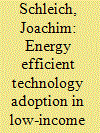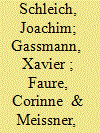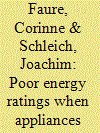|
|
|
Sort Order |
|
|
|
Items / Page
|
|
|
|
|
|
|
| Srl | Item |
| 1 |
ID:
117004


|
|
|
|
|
| Publication |
2012.
|
| Summary/Abstract |
This paper empirically investigates factors driving the adoption of energy-efficiency measures by small and medium-sized enterprises (SMEs). Our analyses are based on cross-sectional data from SMEs which participated in a German energy audit program between 2008 and 2010. In general, our findings appear robust to alternative model specifications and are consistent with the theoretical and still scarce empirical literature on barriers to energy-efficiency in SMEs. More specifically, high investment costs, which are captured by subjective and objective proxies, appear to impede the adoption of energy-efficiency measures, even if these measures are deemed profitable. Similarly, we find that lack of capital slows the adoption of energy-efficiency measures, primarily for larger investments. Hence, investment subsidies or soft loans (for larger investments) may help accelerating the diffusion of energy-efficiency measures in SMEs. Other barriers were not found to be statistically significant. Finally, our findings provide evidence that the quality of energy audits affects the adoption of energy-efficiency measures. Hence, effective regulation should involve quality standards for energy audits, templates for audit reports or mandatory monitoring of energy audits.
|
|
|
|
|
|
|
|
|
|
|
|
|
|
|
|
| 2 |
ID:
177357


|
|
|
|
|
| Summary/Abstract |
Energy efficiency policies often involve low-interest loans for retrofit measures in private buildings; the main target of these loans are meant to be households with otherwise poor access to capital. However, such programs can only be successful if the targeted households also take up these loans. This paper studies the relation between access to capital and debt aversion and the adoption of retrofit measures in European Union countries, employing a demographically representative household survey including about 6600 homeowners in France, Germany, Italy, Poland, Romania, Spain, Sweden, and the United Kingdom. The findings suggest that debt aversion negatively affects the adoption of retrofit measures by homeowners. In particular, debt-averse homeowners with poor access to capital are less likely to have adopted retrofit measures than non-debt-averse homeowners with poor access to capital. The findings further provide evidence that low-interest loan programs should be targeted at younger homeowners with lower income and less formal education.
|
|
|
|
|
|
|
|
|
|
|
|
|
|
|
|
| 3 |
ID:
137658


|
|
|
|
|
| Summary/Abstract |
As countries move toward larger shares of renewable electricity, the slow diffusion of active electricity load management should concern energy policy makers and users alike. Active load management can increase capacity factors and thereby reduce the need for new capacity, improve reliability, and lower electricity prices. This paper conceptually and empirically explores barriers to load shift in industry from an end-user perspective. An online survey, based on a taxonomy of barriers developed in the realm of energy efficiency, was carried out among manufacturing sites in mostly Southern Germany. Findings suggest that the most important barriers are risk of disruption of operations, impact on product quality, and uncertainty about cost savings. Of little concern are access to capital, lack of employee skills, and data security. Statistical tests suggest that companies for which electricity has higher strategic value rate financial and regulatory risk higher than smaller ones. Companies with a continuous production process report lower barrier scores than companies using batch or just-in-time production. A principal component analysis clusters the barriers and multivariate analysis with the factor scores confirms the prominence of technical risk as a barrier to load shift. The results provide guidance for policy making and future empirical studies.
|
|
|
|
|
|
|
|
|
|
|
|
|
|
|
|
| 4 |
ID:
132595


|
|
|
|
|
| Publication |
2014.
|
| Summary/Abstract |
This paper quantifies the direct rebound effects associated with the switch from incandescent lamps (ILs) or halogen bulbs to more energy efficient compact fluorescent lamps (CFLs) or light emitting diodes (LEDs) using a large nationally representative survey of German households. The direct rebound effect is measured as the elasticity of energy demand for lighting with respect to changes in energy efficient lamps. In particular, the rebound effect is decomposed into changes in lamp luminosity and burn time. For the average bulb, the associated total direct rebound effect is estimated at about 6%. The larger part (around 60%) of this rebound effect results from increases in bulb luminosity. For the most frequent (modal) bulb switch, i.e. the replacement of the main bulb in the living or dining room, the total direct rebound effect is just below 3%, with around 60% attributable to an increase in burn time. Average and modal bulb differences suggest that the magnitude of the rebound effect may decrease with intensity of initial bulb use. The magnitude of the direct rebound and the relative contributions of changes in luminosity and burn time also differ by initial bulb type and by replacement bulb type.
|
|
|
|
|
|
|
|
|
|
|
|
|
|
|
|
| 5 |
ID:
054705


|
|
|
|
|
| Publication |
Cheltenham, Edward Elgar, 2004.
|
| Description |
x, 349p.
|
| Standard Number |
1840648899
|
|
|
|
|
|
|
|
|
|
|
|
Copies: C:1/I:0,R:0,Q:0
Circulation
| Accession# | Call# | Current Location | Status | Policy | Location |
| 048899 | 333.79/SOR 048899 | Main | On Shelf | General | |
|
|
|
|
| 6 |
ID:
125620


|
|
|
|
|
| Publication |
2013.
|
| Summary/Abstract |
This paper analyzes the effects of providing feedback on electricity consumption in a field trial involving more than 1500 households in Linz, Austria. About half of these households received feedback together with information about electricity-saving measures (pilot group), while the remaining households served as a control group. Participation in the pilot group was random, but households were able to choose between two types of feedback: access to a web portal or written feedback by post. Results from cross section OLS regression suggest that feedback provided to the pilot group corresponds with electricity savings of around 4.5% for the average household. Our results from quantile regressions imply that for households in the 30th to the 70th percentile of electricity consumption, feedback on electricity consumption is statistically significant and effects are highest in absolute terms and as a share of electricity consumption. For percentiles below or above this range, feedback appears to have no effect. Finally, controlling for a potential endogeneity bias induced by non random participation in the feedback type groups, we find no difference in the effects of feedback provided via the web portal and by post.
|
|
|
|
|
|
|
|
|
|
|
|
|
|
|
|
| 7 |
ID:
179667


|
|
|
|
|
| Summary/Abstract |
The European Union has decided to replace its previously existing A+++ to D labelling scheme for cold appliances with a rescaled A to G labelling scheme in 2021. Employing a demographically representative discrete choice experiment on refrigerator adoption using an online survey among more than 1000 households in Germany, this paper explores the effects of the rescaled scheme compared to the previous scheme on the stated uptake of top-rated refrigerators, i.e. those classified A+++ under the previous scheme and B under the rescaled scheme. Since in practice both schemes may be shown for a transitory period, the paper also explores the effects of displaying both labels simultaneously. The findings from estimating a mixed logit model suggest that showing the rescaled label alone significantly increases valuation of top-rated refrigerators compared to showing the previous A+++ to D label alone. In comparison, when the previous A+++ to D and the rescaled A to G schemes are shown simultaneously, no benefits of introducing the rescaled label are found. Thus, policymakers should strive to enforce the application of the rescaled labelling scheme as quickly as possible and to shorten transitory periods where both labels are shown simultaneously.
|
|
|
|
|
|
|
|
|
|
|
|
|
|
|
|
| 8 |
ID:
162947


|
|
|
|
|
| Summary/Abstract |
This paper studies the adoption of high-cost, medium-cost, and low-cost energy efficient technologies (EETs) by income categories in eight European Union countries, relying on demographically representative household surveys carried out simultaneously among about 15,000 households in France, Germany, Italy, Poland, Romania, Spain, Sweden, and the United Kingdom. The statistical-econometric analyses allow the effects of income to differ by income quartiles in each country. For high cost EETs such as retrofit measures, the findings suggest that homeowners falling into the lowest income quartile exhibit lower adoption propensities than those falling into the highest income quartile. These findings provide some support for policies targeting “poor homeowners”, particularly in lower-income countries with a high share of owner-occupiers such as Poland and Romania. Further, differences in adoption propensities across income quartiles also exist for medium- and low-cost EETs such as appliances and light bulbs. Finally, analyzing factors related to homeowners receiving financial support for retrofit measures from governments or utilities suggests that differences in implementation rates between the highest and lowest income quartile would likely have been higher without such support schemes in place. For the United Kingdom (but not for other countries) these schemes appeared to have had a progressive effect.
|
|
|
|
|
|
|
|
|
|
|
|
|
|
|
|
| 9 |
ID:
105789


|
|
|
|
|
| Publication |
2011.
|
| Summary/Abstract |
A multi-region, multi-sector dynamic computable general equilibrium model is applied to explore the economic and welfare effects of the pledges submitted by developed countries (Annex I countries) and major developing (non-Annex I) countries for 2020 under the Copenhagen Accord. In addition to analyzing scenarios reflecting the upper and lower bounds of the Copenhagen Pledges, one additional policy scenario where Annex I countries as a group reduce CO2-emissions by 30% in 2020 compared to 1990 levels, and where major non-Annex I countries reduce CO2 emissions 15% below baseline, is also analyzed. Economic effects are measured as changes in GDP compared to baseline and welfare effects are measured via the equivalent variation. Assuming that countries with emission targets may trade certificates, average reductions in GDP for countries with targets range between 0.1% and 0.7% in 2020 for the policy scenarios. While the GDP losses are larger for major non-Annex I countries with emission targets compared to Annex I countries, this is not the case for the changes in welfare. With the exception of Mexico, the welfare losses for the major non-Annex I regions, as a percentage of projected GDP in 2020, are lower than for the large Annex I countries.
|
|
|
|
|
|
|
|
|
|
|
|
|
|
|
|
| 10 |
ID:
177308


|
|
|
|
|
| Summary/Abstract |
In most countries, minimum energy performance standards (MEPS) and energy labels are the key policies to accelerate the diffusion of energy-efficient appliances and to help meet energy efficiency and climate policy targets. This paper estimates country-specific multivariate econometric models for eight EU countries over the period of 2007–2017 to evaluate the combined effects of changes in the MEPS and the energy labels entering into force in the EU in 2010 and 2011. The findings suggest that these policies increased the market share of cold appliances (refrigerators and fridge-freezer combinations) with an energy label of A+ and better between about 15 and 38 percentage points. For these appliances, autonomous developments (captured through a time trend) are estimated to range between 5 and 10 percentage points per year. Thus, failure to account for autonomous developments would have resulted in substantially overestimating the combined effects of MEPS and energy label policies in the EU. The findings further imply that policy evaluations should allow for policy effectiveness and autonomous developments to differ across countries.
|
|
|
|
|
|
|
|
|
|
|
|
|
|
|
|
| 11 |
ID:
190586


|
|
|
|
|
| Summary/Abstract |
Leading energy-economic models used for policy assessment employ implicit discount rates (IDRs) to model household energy efficiency technology adoption, typically assuming identical IDRs across households and countries. To help modelers and policy-makers get tangible insights about the IDR, we empirically analyse the relations among key factors underlying the IDR and socio-demographic characteristics based on large-scale demographically representative household surveys in eight EU countries. These factors include behavioral parameters (time preferences, risk aversion, loss aversion, present bias), environmental identity, preferences for adhering to social norms, and access to capital. The findings suggest that these factors vary by country and socio-demographic characteristics. Notably, higher age, higher income and higher education of individuals typically imply a lower IDR, ceteris paribus. Policy-makers may rely on the results to tailor policy interventions towards socio-economic groups. For example, results on time discounting suggest that policies such as rebates or loans should target low-education individuals. Results on risk aversion suggest that policies such as warranties or energy performance contracting should target older and low-education individuals and low-income households. Finally, policies addressing lack of access to capital such as grants and soft loans appear most effective for younger, low-education individuals and single, low-income, non-urban households.
|
|
|
|
|
|
|
|
|
|
|
|
|
|
|
|
| 12 |
ID:
150039


|
|
|
|
|
| Summary/Abstract |
Implicit discount rates (IDRs) are employed in energy models to capture household investment decisions, yet the factors behind the IDR and their respective implications for policy-making usually remain blurred and fractional. The proposed comprehensive framework distinguishes three broad categories of factors underlying the IDR for household adoption of energy-efficient technologies (EETs): preferences (notably over time, risk, loss, debt, and the environment), predictable (ir)rational behavior (bounded rationality, rational inattention, behavioral biases), and external barriers to energy efficiency. Existing empirical findings suggest that the factors underlying the IDRs that differ across household characteristics and technologies should be accounted for in energy models. Furthermore, the framework allows for a fresh look at the interplay of IDRs and policies. We argue that a simple observation of high IDRs (or observing correlations between IDRs and socio-economic characteristics) does not provide guidance for policy-making since the underlying sources cannot be identified. Instead, we propose that some of the factors underlying the IDR - notably external barriers - can be changed (through directed policy interventions) whereas other factors - notably preferences and predictable (ir)rational behavior - are innate and can only be taken into account (through reactive policy interventions).
|
|
|
|
|
|
|
|
|
|
|
|
|
|
|
|
| 13 |
ID:
176658


|
|
|
|
|
| Summary/Abstract |
Conveyance, i.e., leaving one's appliance in the dwelling when moving out, shortens the expected length of ownership of an appliance and may therefore lead to the purchase of less energy-efficient appliances. Employing a demographically representative survey in Spain, this paper uses statistical-econometric analyses to explore the effects of conveyance on stated adoption of energy-efficient appliances (refrigerators or fridge-freezer combinations, freezers, dishwashers, and washing machines). The findings suggest that the take-up of energy-efficient appliances is on average about 8%-points lower when appliances convey. In addition, conveyance appears to have comparable effects for renters and homeowners. These findings therefore suggest that conveyance contributes to explaining the energy efficiency paradox. Finally, the results appear robust to a series of robustness checks involving alternative assumptions about the distribution and data generating process, the specifications of the dependent variable, and the handling of missing values. They also provide insights for policy-making.
|
|
|
|
|
|
|
|
|
|
|
|
|
|
|
|
| 14 |
ID:
091700


|
|
|
|
|
| Publication |
2009.
|
| Summary/Abstract |
Solar thermal technologies offer the potential to meet a substantial share of residential water and space heating needs in the EU, but current levels of adoption are low. This paper uses data from a large sample of German households to assess the effects of geographic, residence, and household characteristics on the adoption of solar thermal water and space heating technologies. In addition, the impact of solar thermal technology adoption on household energy expenditures is estimated after controlling for observed household heterogeneity in geographic, residential, and household characteristics. While evidence is found of moderate household energy expenditure savings from combined solar water and space heating systems, the findings generally confirm that low in-home energy cost savings and fixed housing stocks limit the diffusion of residential solar thermal technologies. Little evidence is found of differential adoption by distinct socio-economic groups.
|
|
|
|
|
|
|
|
|
|
|
|
|
|
|
|
| 15 |
ID:
115690


|
|
|
|
|
| Publication |
2012.
|
| Summary/Abstract |
Relationships between measures of household energy use behavior and household characteristics are estimated using a unique dataset of approximately 5000 households in 10 EU countries and Norway. Family age-composition patterns are found to have a distinct impact on household energy use behavior. Households with young children are more likely to adopt energy-efficient technologies and energy conservation practices and place primary importance on energy savings for environmental reasons. By contrast, households with a high share of elderly members place more importance on financial savings, and have lower levels of technology adoption, energy conservation practice use, and knowledge about household energy use. Education levels also matter, with higher levels associated with energy-efficient technology adoption and energy conservation practice use. Similarly, university education increases the stated importance of energy savings for greenhouse gas reductions and decreases the stated importance for financial reasons. Education impacts also vary greatly across survey countries and there is some evidence of an Eastern-Western European divide with respect to attitudes towards energy savings. These cross-country differences highlight the need to balance a common EU energy-efficiency policy framework with flexibility for country specific policies to address unique constraints to energy-efficient technology and conservation practice adoption.
|
|
|
|
|
|
|
|
|
|
|
|
|
|
|
|
| 16 |
ID:
094226


|
|
|
| 17 |
ID:
181424


|
|
|
|
|
| Summary/Abstract |
By offering to rent energy technologies, energy suppliers and other companies may tap into new market segments, allowing them to preserve or increase market shares. Because such rental services can help overcome capital-related and other barriers to energy efficiency, they may also contribute to achieving ambitious energy and climate targets. Yet, empirical analyses of renting energy technologies are scarce. Employing a large-scale discrete choice experiment among owner-occupiers in the United Kingdom, this study explores households' willingness-to-pay for renting compared to owning their new heating system. The findings obtained from mixed logit models suggest that, on average, participants strongly dislike renting compared to owning their new heating system, in particular owner-occupiers who are older than 70 years. However, about a third of the sample is estimated to prefer renting. On average, participants also value heating cost savings associated with energy-efficient heating systems and longer warranty periods. Finally, the paper discusses implications for policy-makers and for providers of heating system rental services.
|
|
|
|
|
|
|
|
|
|
|
|
|
|
|
|
|
|
|
|
|